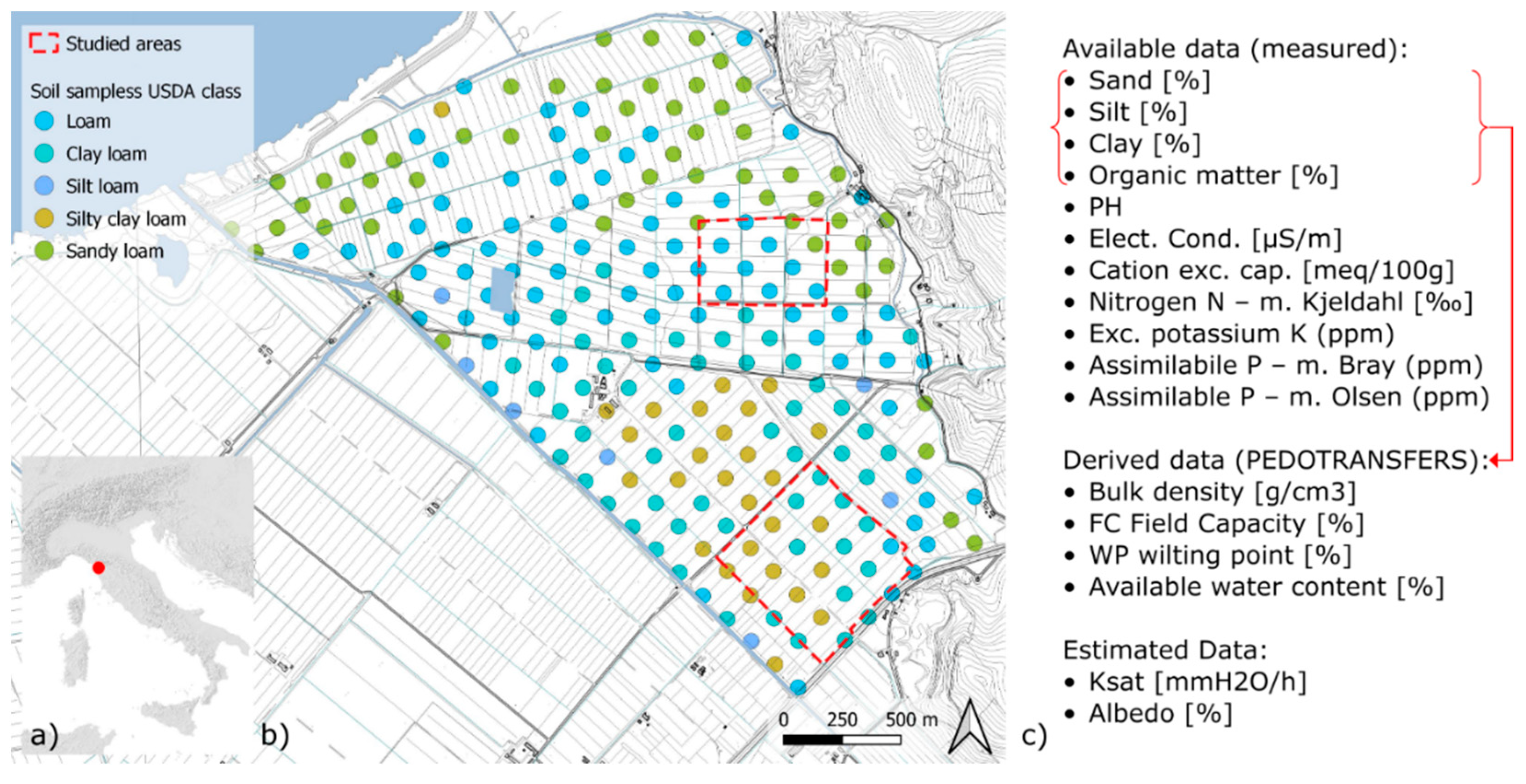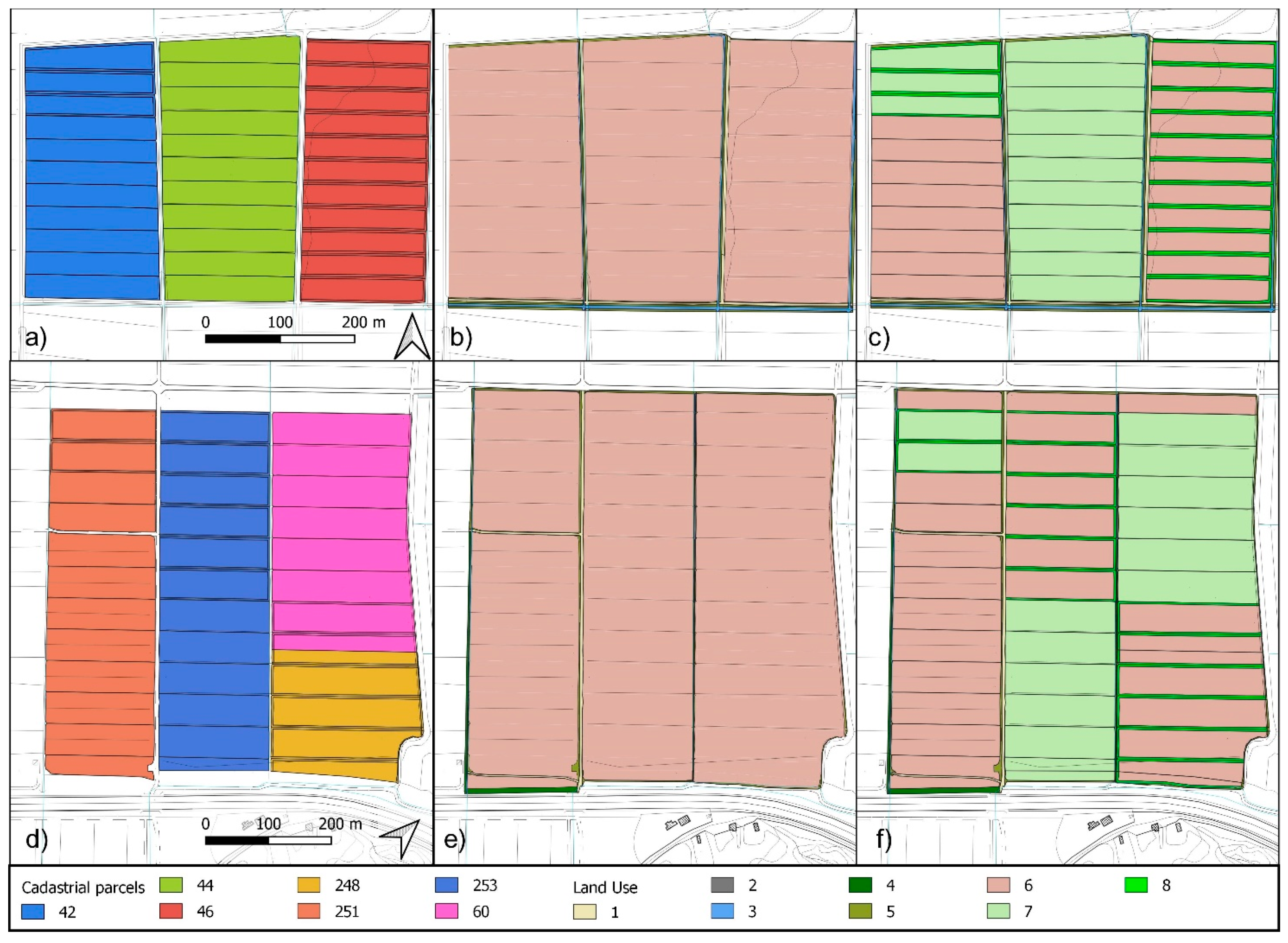Modelling Approach for NBSs Suitability Assessment in an Agricultural Area under Changing Climate Conditions: Case Studies in the Massaciuccoli Catchment (Central Italy) †
Abstract
1. Introduction
Study Area
2. Methods
3. Results and Discussion
4. Conclusions
Author Contributions
Funding
Institutional Review Board Statement
Informed Consent Statement
Data Availability Statement
Acknowledgments
Conflicts of Interest
References
- Linsley, R.K. The Relation between Rainfall and Runoff: Review Paper. J. Hydrol. 1967, 5, 297–311. [Google Scholar] [CrossRef]
- Peel, M.C.; McMahon, T.A. Historical Development of Rainfall-Runoff Modeling. Wiley Interdiscip. Rev. Water 2020, 7, e1471. [Google Scholar] [CrossRef]
- Sharpley, A.N. Depth of Surface Soil-Runoff Interaction as Affected by Rainfall, Soil Slope, and Management. Soil Sci. Soc. Am. J. 1985, 49, 1010–1015. [Google Scholar] [CrossRef]
- Wallace, C.W.; Flanagan, D.C.; Engel, B.A. Quantifying the Effects of Conservation Practice Implementation on Predicted Runoff and Chemical Losses under Climate Change. Agric. Water Manag. 2017, 186, 51–65. [Google Scholar] [CrossRef]
- Burkart, M. The Hydrologic Footprint of Annual Crops. In A Watershed Year: Anatomy of the Iowa Floods of 2008; University of Iowa Press: Iowa City, IA, USA, 2010. [Google Scholar]
- Clarke, L.; Edmonds, J.; Jacoby, H.; Pitcher, H.; Reilly, R.; Richels, R. Scenarios of Greenhouse Gas Emissions and Atmospheric Concentrations. In Sub-Report 2.1a of Synthesis and Assessment Product 2.1 by the U.S. Climate Change Science Program and the Subcommittee on Global Change Research; Department of Energy, Office of Biological & Environmental Research: Washington, DC, USA, 2007. [Google Scholar]
- Moss, R.H.; Edmonds, J.A.; Hibbard, K.A.; Manning, M.R.; Rose, S.K.; van Vuuren, D.P.; Carter, T.R.; Emori, S.; Kainuma, M.; Kram, T.; et al. The Next Generation of Scenarios for Climate Change Research and Assessment. Nature 2010, 463, 747–756. [Google Scholar] [CrossRef]
- Arnold, J.G.; Moriasi, D.N.; Gassman, P.W.; Abbaspour, K.C.; White, M.J.; Srinivasan, R.; Santhi, C.; Harmel, R.D.; van Griensven, A.; van Liew, M.W.; et al. SWAT: Model Use, Calibration, and Validation. Trans. ASABE 2012, 55, 1491–1508. [Google Scholar] [CrossRef]
- Bieger, K.; Arnold, J.G.; Rathjens, H.; White, M.J.; Bosch, D.D.; Allen, P.M.; Volk, M.; Srinivasan, R. Introduction to SWAT+, A Completely Restructured Version of the Soil and Water Assessment Tool. JAWRA J. Am. Water Resour. Assoc. 2017, 53, 115–130. [Google Scholar] [CrossRef]
- Karki, R.; Srivastava, P.; Veith, T.L. Application of the Soil and Water Assessment Tool (SWAT) at Field Scale: Categorizing Methods and Review of Applications. Trans. ASABE 2020, 63, 513–522. [Google Scholar] [CrossRef]
- Sinnathamby, S.; Douglas-Mankin, K.R.; Craige, C. Field-Scale Calibration of Crop-Yield Parameters in the Soil and Water Assessment Tool (SWAT). Agric. Water Manag. 2017, 180, 61–69. [Google Scholar] [CrossRef]
- Bosch, D.D.; Sheridan, J.M.; Batten, H.L.; Arnold, J.G. Evaluation Of The Swat Model On A Coastal Plain Agricultural Watershed. Trans. ASAE 2004, 47, 1493. [Google Scholar] [CrossRef]
- Donmez, C.; Sari, O.; Berberoglu, S.; Cilek, A.; Satir, O.; Volk, M. Improving the Applicability of the SWAT Model to Simulate Flow and Nitrate Dynamics in a Flat Data-Scarce Agricultural Region in the Mediterranean. Water 2020, 12, 3479. [Google Scholar] [CrossRef]
- Arabi, M.; Frankenberger, J.R.; Engel, B.A.; Arnold, J.G. Representation of Agricultural Conservation Practices with SWAT. Hydrol. Processes 2008, 22, 3042–3055. [Google Scholar] [CrossRef]
- White, M.J.; Arnold, J.G. Development of a Simplistic Vegetative Filter Strip Model for Sediment and Nutrient Retention at the Field Scale. Hydrol. Processes 2009, 23, 1602–1616. [Google Scholar] [CrossRef]
- Arnold, J.G.; Allen, P.M. Automated Methods for Estimating Baseflow and Ground Water Recharge from Streamflow Records. Journal of the American Water Resour. Assoc. 1999, 35, 411–424. [Google Scholar] [CrossRef]
- Renard, K.; Foster, G.; Weesies, G.; Porter, J. RUSLE: Revised Universal Soil Loss Equation. J. Soil Water Conserv. 1991, 46, 105–126. [Google Scholar]
- Munoz-Caprina, R.; Parsons, J.E.; Gilliam, J.W. Modelling Hydrology and Sediment Movement. J. Hydrol. 1999, 214, 111–129. [Google Scholar] [CrossRef]
- OECD Report of the OECD Pesticide Aquatic Risk Indicators Expert Group. Organisation for Economic Co-Operation and Development . 2000. Available online: https://www.oecd.org/ (accessed on 17 October 2022).
- PHUSICOS R&D Project-Horizon. 2020. Available online: https://phusicos.eu/ (accessed on 10 September 2021).
- Dile, Y.T.; Srinivasan, R.; George, C. QGIS Interface for SWAT+: QSWAT+. User Manual v2.2. March 2022. 2022. Available online: https://swatplus.gitbook.io/docs/user/qswat+ (accessed on 24 October 2022).
- Silvestri, N.; Risaliti, R.; Ginanni, M.; Accogli, D.; Sabbatini, T.; Tozzini, C. Application of a Georeferenced Soil Database in a Protected Area of Migliarino San Rossore Massaciuccoli Park. In Proceedings of the VII Congress of the European Society for Agronomy, Cordoba, Spain, 15–18 July 2002. [Google Scholar]
- Hollis, J.M.; Hannam, J.; Bellamy, P.H. Empirically-Derived Pedotransfer Functions for Predicting Bulk Density in European Soils. Eur. J. Soil Sci. 2012, 63, 96–109. [Google Scholar] [CrossRef]
- Williams, J.R. The EPIC Model. In Computer Models of Watershed Hydrology; Singh, V.P., Ed.; Water Resources Publications: Littleton, CO, USA, 1995; pp. 909–1000. [Google Scholar]
- Hutson, J.L.; Wagenet, R.J. LEACHM: Leaching Estimation And Chemistry Mo-Del: A Process-Based Model of Water and Solute Movement, Transformations, Plant Uptake and Chemical Reactions in the Unsaturated Zone. Version 3.0: Research Series No. 93-3; Cornell University: Ithaca, NY, USA, 1992. [Google Scholar]
- Tuscany Region SIR -DATA/Historical Archive. Available online: http://www.sir.toscana.it/consistenza-rete (accessed on 4 October 2021).
- Ahmed, K.F.; Wang, G.; Silander, J.; Wilson, A.M.; Allen, J.M.; Horton, R.; Anyah, R. Statistical Downscaling and Bias Correction of Climate Model Outputs for Climate Change Impact Assessment in the U.S. Northeast. Glob. Planet. Change 2013, 100, 320–332. [Google Scholar] [CrossRef]
- Hempel, S.; Frieler, K.; Warszawski, L.; Schewe, J.; Piontek, F. A Trend-Preserving Bias Correction—The ISI-MIP Approach. Earth Syst. Dyn. 2013, 4, 219–236. [Google Scholar] [CrossRef]
- Ines, A.V.M.; Hansen, J.W. Bias Correction of Daily GCM Rainfall for Crop Simulation Studies. Agric. For. Meteorol. 2006, 138, 44–53. [Google Scholar] [CrossRef]
- Teutschbein, C.; Seibert, J. Bias Correction of Regional Climate Model Simulations for Hydrological Climate-Change Impact Studies: Review and Evaluation of Different Methods. J. Hydrol. 2012, 456–457, 12–29. [Google Scholar] [CrossRef]
- Ashraf Vaghefi, S.; Abbaspour, N.; Kamali, B.; Abbaspour, K.C. A Toolkit for Climate Change Analysis and Pattern Recognition for Extreme Weather Conditions—Case Study: California-Baja California Peninsula. Environ. Model. Softw. 2017, 96, 181–198. [Google Scholar] [CrossRef]
- Dile, Y.T.; Daggupati, P.; George, C.; Srinivasan, R.; Arnold, J. Introducing A New Open Source GIS User Interface for the SWAT Model. Environ. Model. Softw. 2016, 85, 129–138. [Google Scholar] [CrossRef]


| Model | Advantages | Disadvantages |
|---|---|---|
| RUSLE [17] (Ma) |
|
|
| SWAT [9] (S, Ma, Mo, D) |
|
|
| VFSMOD [18] (S, Ma, Mo) |
|
|
| REXTOX [19] (S, Ma, D) |
|
|
| CLIMATE | SCENARIO | Average Annual Rainfalls (mm × y−1) | Runoff (mm × y−1) | Sediment Yield (t × ha−1 × y−1) |
|---|---|---|---|---|
| Weighted mean | Weighted mean | |||
| STUDIATI | ||||
| Current | S0 | 1178 | 89 | 0.14 |
| S1 | 1178 | 87 | 0.09 | |
| Future 4.5 | S0 | 899 | 16 | 0.01 |
| S1 | 899 | 16 | 0.01 | |
| Future 8.5 | S0 | 738 | 16 | 0.02 |
| S1 | 738 | 16 | 0.01 | |
| GIOIA | ||||
| Current | S0 | 1178 | 70 | 3.47 |
| S1 | 1178 | 68 | 0.43 | |
| Future 4.5 | S0 | 899 | 77 | 1.76 |
| S1 | 899 | 74 | 0.45 | |
| Future 8.5 | S0 | 738 | 50 | 2.94 |
| S1 | 738 | 48 | 0.55 | |
Publisher’s Note: MDPI stays neutral with regard to jurisdictional claims in published maps and institutional affiliations. |
© 2022 by the authors. Licensee MDPI, Basel, Switzerland. This article is an open access article distributed under the terms and conditions of the Creative Commons Attribution (CC BY) license (https://creativecommons.org/licenses/by/4.0/).
Share and Cite
Pignalosa, A.; Silvestri, N.; Pugliese, F.; Gerundo, C.; Del Seppia, N.; Lucchesi, M.; De Paola, F. Modelling Approach for NBSs Suitability Assessment in an Agricultural Area under Changing Climate Conditions: Case Studies in the Massaciuccoli Catchment (Central Italy). Environ. Sci. Proc. 2022, 21, 44. https://doi.org/10.3390/environsciproc2022021044
Pignalosa A, Silvestri N, Pugliese F, Gerundo C, Del Seppia N, Lucchesi M, De Paola F. Modelling Approach for NBSs Suitability Assessment in an Agricultural Area under Changing Climate Conditions: Case Studies in the Massaciuccoli Catchment (Central Italy). Environmental Sciences Proceedings. 2022; 21(1):44. https://doi.org/10.3390/environsciproc2022021044
Chicago/Turabian StylePignalosa, Antonio, Nicola Silvestri, Francesco Pugliese, Carlo Gerundo, Nicola Del Seppia, Massimo Lucchesi, and Francesco De Paola. 2022. "Modelling Approach for NBSs Suitability Assessment in an Agricultural Area under Changing Climate Conditions: Case Studies in the Massaciuccoli Catchment (Central Italy)" Environmental Sciences Proceedings 21, no. 1: 44. https://doi.org/10.3390/environsciproc2022021044
APA StylePignalosa, A., Silvestri, N., Pugliese, F., Gerundo, C., Del Seppia, N., Lucchesi, M., & De Paola, F. (2022). Modelling Approach for NBSs Suitability Assessment in an Agricultural Area under Changing Climate Conditions: Case Studies in the Massaciuccoli Catchment (Central Italy). Environmental Sciences Proceedings, 21(1), 44. https://doi.org/10.3390/environsciproc2022021044








